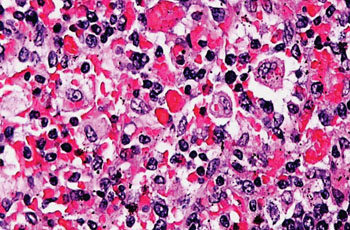Prognostic Factors in Children with HLH Investigated
|
By LabMedica International staff writers Posted on 27 Oct 2016 |

Image: A photomicrograph of a bone marrow showing stromal macrophages containing numerous red blood cells in their cytoplasm from a patient with hemophagocytic lymphohistiocytosis (Photo courtesy of Nephron).
Hemophagocytic lymphohistiocytosis (HLH) is a rare disease characterized by a rapidly fatal hematological disorder usually associated with malignancies and severe infections and it presents with prolonged high fever that could not be controlled by antibiotics.
Other manifestations of HLH are hepatosplenomegaly, cytopenia, widespread infiltration with lymphocytes, and benign-looking histiocytes with hemophagocytosis in the bone marrow, liver, spleen, or lymph nodes. Early diagnosis and combined treatment can effectively control this life-threatening disease.
Scientists at the Guangdong Medical College (Shenzhen, People’s Republic of China) carried out a retrospective analysis on HLH from January 1, 2000, to November 30, 2013. Of the 56 pediatric patients, 35 were boys and 21 were girls with a median age of 4.5 years (range: four months to 12 years) at the onset of HLH. The median duration before diagnosis of HLH was 1.5 weeks (range: one week to six weeks). The most common clinical symptoms observed were fever (100%), hepatomegaly or splenomegaly (95.24%), and pancytopenia (100%).
The team found that characteristic laboratory values presented with increased ferritin (64.29%), triglycerides (78.6%), transaminases (81%), bilirubin (67.5%), lactate dehydrogenase (95.2%), and decreased fibrinogen (61.9%), sodium (40.5%), and potassium (30.9%). Bone marrow aspiration showed hemophagocytosis in 48 cases (85.7%). Among the clinical and laboratory features analyzed, high lactate dehydrogenase (LDH) of greater than 2,000 U/L, high bilirubin of greater than 2 mg/mL, and younger age less than 2 years old at the time of diagnosis indicated worst outcome.
Anemia was observed in 39 patients (five cases with hemoglobin level less than 90 g/L, 27 cases less than 60–89 g/L, seven cases less than 30–59 g/L), neutropenia (neutrophil count less than 1.5×109/L) in 28 patients (22 cases less than 0.5–1.0×109/L, and five cases less than 0.5×109/L, and thrombocytopenia (platelet count less than 100×109/L) in 35 patients (33 cases with platelet count less than 20–99×109/L and two cases with platelet count less than 20×109/L). Examination of bone marrow aspiration showed hemophagocytosis in 48 (85.7%) patients.
The authors concluded that the etiology of HLH is complicated and early diagnosis is difficult. The level of LDH and bilirubin may predict the severity of HLH and depending on the clinical presentation, individualized therapy is needed for different patients. The study was published on October 11, 2016, in the Journal of Blood Medicine.
Related Links:
Guangdong Medical College
Other manifestations of HLH are hepatosplenomegaly, cytopenia, widespread infiltration with lymphocytes, and benign-looking histiocytes with hemophagocytosis in the bone marrow, liver, spleen, or lymph nodes. Early diagnosis and combined treatment can effectively control this life-threatening disease.
Scientists at the Guangdong Medical College (Shenzhen, People’s Republic of China) carried out a retrospective analysis on HLH from January 1, 2000, to November 30, 2013. Of the 56 pediatric patients, 35 were boys and 21 were girls with a median age of 4.5 years (range: four months to 12 years) at the onset of HLH. The median duration before diagnosis of HLH was 1.5 weeks (range: one week to six weeks). The most common clinical symptoms observed were fever (100%), hepatomegaly or splenomegaly (95.24%), and pancytopenia (100%).
The team found that characteristic laboratory values presented with increased ferritin (64.29%), triglycerides (78.6%), transaminases (81%), bilirubin (67.5%), lactate dehydrogenase (95.2%), and decreased fibrinogen (61.9%), sodium (40.5%), and potassium (30.9%). Bone marrow aspiration showed hemophagocytosis in 48 cases (85.7%). Among the clinical and laboratory features analyzed, high lactate dehydrogenase (LDH) of greater than 2,000 U/L, high bilirubin of greater than 2 mg/mL, and younger age less than 2 years old at the time of diagnosis indicated worst outcome.
Anemia was observed in 39 patients (five cases with hemoglobin level less than 90 g/L, 27 cases less than 60–89 g/L, seven cases less than 30–59 g/L), neutropenia (neutrophil count less than 1.5×109/L) in 28 patients (22 cases less than 0.5–1.0×109/L, and five cases less than 0.5×109/L, and thrombocytopenia (platelet count less than 100×109/L) in 35 patients (33 cases with platelet count less than 20–99×109/L and two cases with platelet count less than 20×109/L). Examination of bone marrow aspiration showed hemophagocytosis in 48 (85.7%) patients.
The authors concluded that the etiology of HLH is complicated and early diagnosis is difficult. The level of LDH and bilirubin may predict the severity of HLH and depending on the clinical presentation, individualized therapy is needed for different patients. The study was published on October 11, 2016, in the Journal of Blood Medicine.
Related Links:
Guangdong Medical College
Latest Hematology News
- MRD Tests Could Predict Survival in Leukemia Patients
- Platelet Activity Blood Test in Middle Age Could Identify Early Alzheimer’s Risk
- Microvesicles Measurement Could Detect Vascular Injury in Sickle Cell Disease Patients
- ADLM’s New Coagulation Testing Guidance to Improve Care for Patients on Blood Thinners
- Viscoelastic Testing Could Improve Treatment of Maternal Hemorrhage
- Pioneering Model Measures Radiation Exposure in Blood for Precise Cancer Treatments
- Platelets Could Improve Early and Minimally Invasive Detection of Cancer
- Portable and Disposable Device Obtains Platelet-Rich Plasma Without Complex Equipment
- Disposable Cartridge-Based Test Delivers Rapid and Accurate CBC Results
- First Point-of-Care Heparin Monitoring Test Provides Results in Under 15 Minutes

- New Scoring System Predicts Risk of Developing Cancer from Common Blood Disorder
- Non-Invasive Prenatal Test for Fetal RhD Status Demonstrates 100% Accuracy
- WBC Count Could Predict Severity of COVID-19 Symptoms
- New Platelet Counting Technology to Help Labs Prevent Diagnosis Errors
- Streamlined Approach to Testing for Heparin-Induced Thrombocytopenia Improves Diagnostic Accuracy
- POC Hemostasis System Could Help Prevent Maternal Deaths
Channels
Clinical Chemistry
view channel
Noninvasive Blood-Glucose Monitoring to Replace Finger Pricks for Diabetics
People with diabetes often need to measure their blood glucose multiple times a day, most commonly through finger-prick blood tests or implanted sensors. These methods can be painful, inconvenient, and... Read more
POC Breath Diagnostic System to Detect Pneumonia-Causing Pathogens
Pseudomonas aeruginosa is a major cause of hospital-acquired and ventilator-associated pneumonia, particularly in lung transplant recipients and patients with structural lung disease. Its ability to form... Read moreMolecular Diagnostics
view channel
World's First NGS-Based Diagnostic Platform Fully Automates Sample-To-Result Process Within Single Device
Rapid point-of-need diagnostics are of critical need, especially in the areas of infectious disease and cancer testing and monitoring. Now, a direct-from-specimen platform that performs genomic analysis... Read more
Rapid Diagnostic Breakthrough Simultaneously Detects Resistance and Virulence in Klebsiella Pneumoniae
Antibiotic resistance is a steadily escalating threat to global healthcare, making common infections harder to treat and increasing the risk of severe complications. One of the most concerning pathogens... Read moreImmunology
view channel
Blood Test Could Identify Colon Cancer Patients to Benefit from NSAIDs
Colon cancer remains a major cause of cancer-related illness, with many patients facing relapse even after surgery and chemotherapy. Up to 40% of people with stage III disease experience recurrence, highlighting... Read moreBlood Test Could Detect Adverse Immunotherapy Effects
Immune checkpoint inhibitors have transformed cancer treatment, but they can also trigger serious immune-related adverse events that damage healthy organs and may become life-threatening if not detected early.... Read moreMicrobiology
view channel
New UTI Diagnosis Method Delivers Antibiotic Resistance Results 24 Hours Earlier
Urinary tract infections affect around 152 million people every year, making them one of the most common bacterial infections worldwide. In routine medical practice, diagnosis often relies on rapid urine... Read more
Breakthroughs in Microbial Analysis to Enhance Disease Prediction
Microorganisms shape human health, ecosystems, and the planet’s climate, yet identifying them and understanding how they are related remains a major scientific challenge. Even with modern DNA sequencing,... Read morePathology
view channel
AI Tool Simultaneously Identifies Genetic Mutations and Disease Type
Interpreting genetic test results remains a major challenge in modern medicine, particularly for rare and complex diseases. While existing tools can indicate whether a genetic mutation is harmful, they... Read more
Rapid Low-Cost Tests Can Prevent Child Deaths from Contaminated Medicinal Syrups
Medicinal syrups contaminated with toxic chemicals have caused the deaths of hundreds of children worldwide, exposing a critical gap in how these products are tested before reaching patients.... Read more
Tumor Signals in Saliva and Blood Enable Non-Invasive Monitoring of Head and Neck Cancer
Head and neck cancers are among the most aggressive malignancies worldwide, with nearly 900,000 new cases diagnosed each year. Monitoring these cancers for recurrence or relapse typically relies on tissue... Read moreTechnology
view channel
Diagnostic Chip Monitors Chemotherapy Effectiveness for Brain Cancer
Glioblastoma is one of the most aggressive and fatal brain cancers, with most patients surviving less than two years after diagnosis. Treatment is particularly challenging because the tumor infiltrates... Read more
Machine Learning Models Diagnose ALS Earlier Through Blood Biomarkers
Amyotrophic lateral sclerosis (ALS) is a rapidly progressive neurodegenerative disease that is notoriously difficult to diagnose in its early stages. Early symptoms often overlap with other neurological... Read moreIndustry
view channel
BD and Penn Institute Collaborate to Advance Immunotherapy through Flow Cytometry
BD (Becton, Dickinson and Company, Franklin Lakes, NJ, USA) has entered into a strategic collaboration with the Institute for Immunology and Immune Health (I3H, Philadelphia, PA, USA) at the University... Read more
























